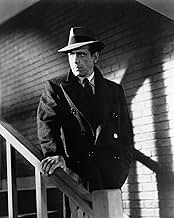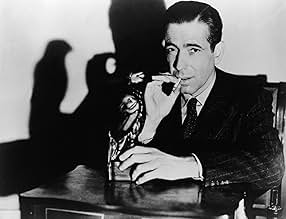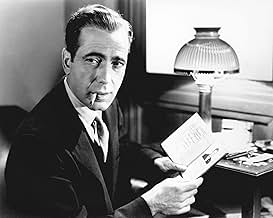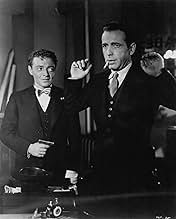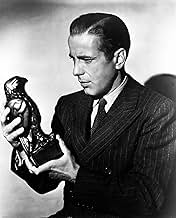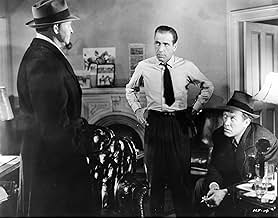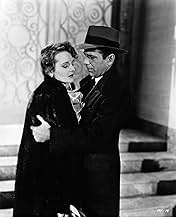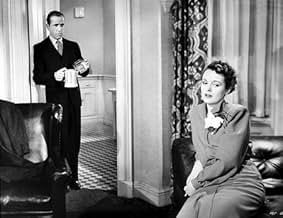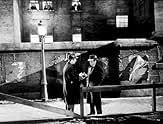Un detective privado asume un caso que lo involucra con tres criminales excéntricos, un mentiroso magnífico y su búsqueda de una estatuilla invaluable.Un detective privado asume un caso que lo involucra con tres criminales excéntricos, un mentiroso magnífico y su búsqueda de una estatuilla invaluable.Un detective privado asume un caso que lo involucra con tres criminales excéntricos, un mentiroso magnífico y su búsqueda de una estatuilla invaluable.
- Dirección
- Guionistas
- Elenco
- Nominado a 3 premios Óscar
- 8 premios ganados y 4 nominaciones en total
Charles Drake
- Reporter
- (sin créditos)
Chester Gan
- Bit Part
- (sin créditos)
Creighton Hale
- Stenographer
- (sin créditos)
Robert Homans
- Policeman
- (sin créditos)
William Hopper
- Reporter
- (sin créditos)
- Dirección
- Guionistas
- Todo el elenco y el equipo
- Producción, taquilla y más en IMDbPro
Opiniones destacadas
With a fine combination of cast, characters, story, and atmosphere, this classic is one of the most entertaining films of its kind, enjoyable even after several viewings. It gets you right into the action and introduces you to a list of interesting personalities, who mesh together nicely and who are also matched well with the cast members. Beyond that, it's also effective as a character study involving greed, trust and distrust, and conflicting ethics.
Sam Spade is an ideal role for Bogart, giving him plenty to work with and some very good dialogue as well. Peter Lorre and Sydney Greenstreet are very entertaining, providing suitable foils for Bogart, and they really take the film up a notch. The rest of the cast also works well (worth mentioning is Elisha Cook, Jr., whose character doesn't do a lot, but who provides Bogart with some very amusing moments at his expense). The story is nicely adapted from the novel, and each scene is constructed well, with everything moving along nicely from start to finish.
If you are a fan of either film noir or mysteries, make this a must-see. There are very few films that work as well as "The Maltese Falcon".
Sam Spade is an ideal role for Bogart, giving him plenty to work with and some very good dialogue as well. Peter Lorre and Sydney Greenstreet are very entertaining, providing suitable foils for Bogart, and they really take the film up a notch. The rest of the cast also works well (worth mentioning is Elisha Cook, Jr., whose character doesn't do a lot, but who provides Bogart with some very amusing moments at his expense). The story is nicely adapted from the novel, and each scene is constructed well, with everything moving along nicely from start to finish.
If you are a fan of either film noir or mysteries, make this a must-see. There are very few films that work as well as "The Maltese Falcon".
"The Maltese Falcon", scripted and directed by Hollywood first-timer John Huston (from Dashiell Hammett's novel), would go on to become an American film classic. Humphrey Bogart chews the scenery in his star-making turn as acid-tongued private eye Sam Spade, whose association with the beautiful and aloof Brigid O'Shaughnessy (Mary Astor), neurotic Joel Cairo (Peter Lorre), and morbidly obese Kasper Gutman (Sydney Greenstreet, in his Oscar-nominated screen debut) over the recovery of the title object, sets in motion a movie experience that is as much crackling as it is dazzling. While much of the action and dialogue is considerably dated by modern standards, the film's essential power to mystify and entrance remains undiminished despite its age. While this was the third adaptation of Hammett's story (the first was made in 1931 and the second was "Satan Met a Lady" (1936)), this is also the best remembered and most praised, due largely in part to Bogart's seemingly effortless portrayal of the tough but softhearted, world-weary hero. Mary Astor and Lee Patrick were, respectively, the definitive femme fatale and girl Friday, and the villianous roles of Cairo, Gutman and Wilmer (Elisha Cook Jr.) were equally remarkable. What may not be wholly obvious is the fact that these three men have homosexual tendencies (as given in the novel), but just look at what's given: Cairo's delicate speech and manner, Wilmer's questionable quick tempered attitude towards Spade (could this be covering up the fact that he finds Spade attractive?) and Gutman's clutching of Spade's arm when Sam arrives at his hotel room. A polished film noir that gave rise to Bogart's mounting popularity. (Sidenote: The character of Sam Spade was originally offered to George Raft, who turned it down. Raft also turned down "Casablanca" (1942), "High Sierra" (1941) and William Wyler's "Dead End" (1937), all of which went to Bogart and helped to boost his star status. Bogart had Raft to thank for his enduring popularity.) A must-see masterpiece. ****
Sam Spade and Miles Archer are detectives, the private type who you can give directives, after meeting with a dame, there then begins a deadly game, with a group who seem to have, their own perspectives; although they all have as their goal a missing falcon, and soon there are some folks, who find their souls gone, as beneath the dark veneer, there are those quite insincere, as you'll find after a number of liaisons; as the story ratchets up the threads combine, and at the centre of the plot's a large waistline, that speaks with eloquence and intent, as deep within, passions ferment, in a film that is a classic of its time.
Great cast, great story, great film - but isn't Sydney Greenstreet outstanding!
Great cast, great story, great film - but isn't Sydney Greenstreet outstanding!
Humphrey Bogart died nearly fifty years ago, but polls still put him at the top of all-time Hollywood stars. What turns a man into a legend? The man himself wasn't much: a slight build, not too tall, no Stallone muscles to swell his suit. What he had in classic films like `The Maltese Falcon' was a voice that cut through a script like a knife. `The Maltese Falcon,' directed by John Huston in 1941, reprised Dashiell Hammett's thriller. (It had been filmed before.) Hammett practically invented the tough guy so deep in cynicism nobody could hope to put anything past him. The novel, thick with plot, wasn't easy for director John Huston to untangle. Few people who cherish this film can summarize its story in a sentence or two. I'll try. San Francisco private eye Sam Spade (Bogart) is pulled into the search for a fabulously valuable statue by a woman who seeks his help. First, his partner is killed, then Spade pushes through her lies to uncover connections to an effete foreigner (Peter Lorre) and a mysterious kingpin (Sydney Greenstreet). The story unfolds like a crumpled paper. But the whodunit becomes less important than how we respond to the strong screen presence of Bogart and his co-stars. That's what makes `The Maltese Falcon' a classic. We see more and appreciate more each time we watch it. The art of Huston and Bogart doesn't come across until a second or third viewing. Huston invented what the French called film noir, in honor of Hollywood films (often `B' movies, cheap to make, second movies in double features) that took no-name stars into city streets to pit tough guys, often with a vulnerable streak, against dangerous dames. Audiences knew that when the tough guy said, `I'm wise to you, babe,' he'd be dead within a reel or two. Bogart was luckier than most noir heroes, but it cost. Struggling to maintain his own independence against the claims of love or his own penchant towards dishonesty the Bogart hero can do little better than surrender, with a rueful shrug, to the irony his survival depends on. The climax of `The Maltese Falcon' ranks with the last scene of `Casablanca,' another Bogart vehicle, in showing how the tough guy has to put himself back together after his emotions almost get the better of him. That assertion of strength, bowed but not broken, defines the enduring quality of Bogart on screen. For Huston, telling this story posed a different problem. Telling it straight wasn't possible too many twists. Huston chose to focus on characters. One way to appreciate Huston's choices is to LISTEN to the movie. Hear the voices. Notice how in long sequences narrating back story, Huston relies on the exotic accents of his characters to keep us interested. Could we endure the scene in which Greenstreet explains the history of the Maltese falcon unless his clipped, somewhat prissy English accent held our attention? Also, we watch Bogart slip into drug-induced sleep while Greenstreet drones on. Has any director thought of a better way to keep us interested during a long narrative interlude? And is there a bit of wit in our watching Bogart nod off during a scene which, if told straight, would make US doze? All of this leads to the ending, minutes of screen time in which more goes on, gesture by gesture, than a million words could summarize. He loves her, maybe, but he won't be a sucker. The cops come in, and the emotional color shifts to gray, the color of film noir heroes like Bogart. Bars on the elevator door as Brigid descends in police custody foreshadow her fate in the last image of Huston's film. But after the film, we're left with Spade, whom we like and loathe, a man whose sense of justice squares, just this once, with our own, maybe. Black and white morality prevails in a black and white movie, but Sam Spade remains gray and so does our response to this film classic.
If not, it's pretty damn close. My husband and I are different than most because instead of just looking for movies we tend to find actors we love and then watch all of their movies. We're fans of the star first and then the movie second. Humphrey Bogart had it all. He was authentic, compelling, and could convey so many emotions with just a twinkle or a tinge of doubt, or suspicion, or fear, or lust, or greed, whatever it was he had to convey, he did it with full conviction. If there's a better movie star that ever lived, I can't name them. There may be actors with more range, but not better movie stars. I think actors can be great even if they don't transform as Day-Lewis does. Don't get me wrong, Day-Lewis is a genius, but an actor who is completely authentic and compelling (something going on underneath) is just as interesting to watch as an actor who transforms themselves.
¿Sabías que…?
- TriviaThree of the falcon statuettes made for the production still exist and are conservatively valued at over $1 million each. This makes them some of the most valuable film props ever made; indeed, each is now worth more than three times what the film cost to make.
- ErroresSpade doesn't wear rings or a watch throughout the movie except for one scene. At one point he walks into his office wearing a wedding band on his left hand, another large ring on his right hand and an expensive looking wristwatch. He sits down to have a quick chat with his secretary where the rings and watch are in plain view. He then walks through a doorway into his inner office and the rings and watch are gone.
- Citas
Joel Cairo: You always have a very smooth explanation ready.
Sam Spade: What do you want me to do, learn to stutter?
- Versiones alternativasAlso available in a computer colorized version.
- ConexionesEdited into Cuentos de la cripta: You, Murderer (1995)
Selecciones populares
Inicia sesión para calificar y agrega a la lista de videos para obtener recomendaciones personalizadas
Detalles
- Fecha de lanzamiento
- País de origen
- Idioma
- También se conoce como
- The Maltese Falcon
- Locaciones de filmación
- Bush Street, San Francisco, California, Estados Unidos(death of Miles Archer)
- Productora
- Ver más créditos de la compañía en IMDbPro
Taquilla
- Presupuesto
- USD 375,000 (estimado)
- Total en EE. UU. y Canadá
- USD 18,180
- Total a nivel mundial
- USD 41,740
- Tiempo de ejecución1 hora 40 minutos
- Color
- Relación de aspecto
- 1.37 : 1
Contribuir a esta página
Sugiere una edición o agrega el contenido que falta



